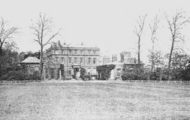Bushy House facts for kids
Quick facts for kids Bushy House |
|
|---|---|

East side of Bushy House in 1992
|
|
| Former names | Upper Lodge |
| General information | |
| Type | House |
| Architectural style | English classical architecture |
| Location | Teddington, London, England |
| Coordinates | 51°25′13″N 0°20′21″W / 51.42028°N 0.33917°W |
| Construction started | 1663 |
| Renovated | 1713–1715 |
| Client | Edward Proger followed by, on rebuild, George Montagu, 1st Earl of Halifax |
| Owner | Part of National Physical Laboratory |
| Design and construction | |
| Architect | William Samwell |
|
Listed Building – Grade II
|
|
| Official name | Bushy House |
| Designated | 2 September 1952 |
| Reference no. | 1080870 |
Bushy House is a historic building in Teddington, London, England. It was once a royal residence for King William IV and his wife, Queen Adelaide. The house was built between 1714 and 1715 by George Montagu, 1st Earl of Halifax. It stands on the site of an older house called Upper Lodge.
Today, Bushy House is part of the National Physical Laboratory (NPL). Its top two floors look out over Bushy Park. In 1900, the house and about 30 acres (120,000 m²) of the park were chosen for the NPL. The laboratory officially opened in 1902. The ground floor and basement of Bushy House were changed into lab spaces. The first director of NPL, Richard Glazebrook, and later directors, lived in part of the building. Bushy House now has laboratories, two small museums with old scientific tools, and rooms for meetings.
Contents
Bushy House: A Journey Through Time
Bushy House has a long and interesting history. It started as a lodge and became a home for royalty and a center for science.
Early Beginnings of Bushy House
The first version of Bushy House was built in 1663. William Samwell designed it for Edward Proger. It cost £4,000, which was a lot of money back then! Proger was made the "Keeper/Ranger" of Bushy Park. This was a reward for his loyalty to King Charles II.
The house was rebuilt between 1714 and 1715. This happened after Charles Montagu, 1st Earl of Halifax bought the park. He then became the Ranger. The house and the Ranger's job later went to his cousin, George Montague, 1st Earl of Halifax. After him, it passed to George's son, George Montague-Dunk, 2nd Earl of Halifax. From 1771 to 1792, Frederick North, Lord North, who was a Prime Minister of Great Britain, lived there.
Royal Residents at Bushy House
In 1797, King George III gave Bushy House to his son, William, Duke of Clarence. William became the new Ranger of Bushy Park. He lived there with his family and children.
When a messenger arrived on June 26, 1830, William learned that the King had died. This meant William was now King! He is said to have joked about sleeping with a queen and went back to bed. After William became King, he made his wife, Princess Adelaide, the Ranger. So, after William's death in 1837, Bushy House became Queen Adelaide's official home. She lived there until she passed away in 1849.
In 1865, Queen Victoria offered Bushy House to the Duc de Nemours. He was a member of the French royal family living in exile. He kept control of the house until his death in 1896. Since he had no children to inherit it, the house became empty in 1897.
A New Purpose: The National Physical Laboratory
Bushy House found a new purpose in 1902. The new National Physical Laboratory (NPL) was opened there. The Prince of Wales, who later became King George V, officially opened it in March 1902. Since then, Bushy House has been a key part of this important scientific research center.
Gallery




